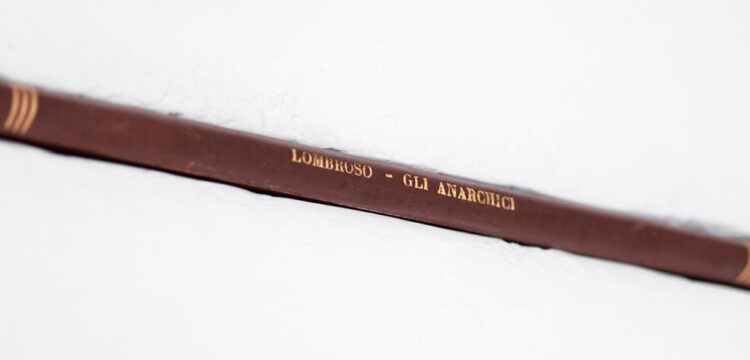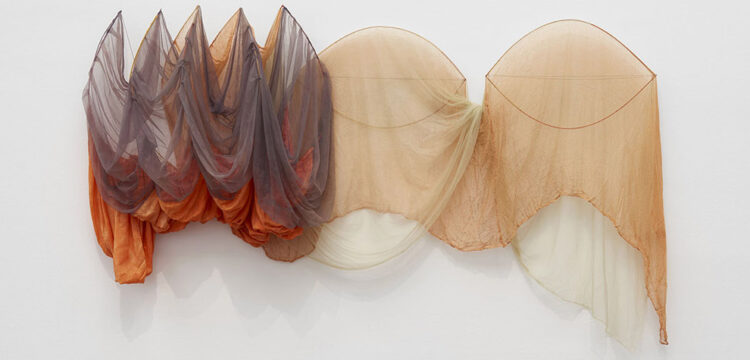Wandering Paths
On Sebastiano Impellizzeri’s exhibition “E se domani non torno, brucia tutto”
Sebastiano Impellizzeri’s first solo exhibition E se domani non torno, brucia tutto, set up at société interludio gallery in Turin, retraces some stages of his research, indicating a new pictorial path, outlining the emergence of a distinct idea of painting. Each of the three exhibition environments is conceived as a paragraph of an overreaching story, and each tells the same tale through a different point of view, a different language.
Sebastiano Impellizzeri’s exhibition E se domani non torno, brucia tutto seems to be composed of suggestive elements. Opening it are five small canvases where dashed signs outline the profiles of naked lying bodies that are barely suggested, meditated, or better remembered, hinted at within a chromatic background created by the breakdown of white into different colors typical of Impellizzeri’s palette: Capriccio, Nudo disteso, Boy 1, Boy 2, Boy 3. The bodies excluded from the works related to the research on cruising return, emerging from the retinal memory which preserves the recollections fixed in the eye’s receptors. As in Compositions, here too color creates semi-transparent surfaces, and from these more defined forms emerge, represented in these new works with a certain absence of volumes. They are forms created by brushstrokes. In the hall, marked by a basic homogeneity linked mainly to a precise chromatic scale, heterogeneous works are exhibited, marking precise stages. In fact, here we find a polyptych, a small landscape, a sculpture, and a monochrome.
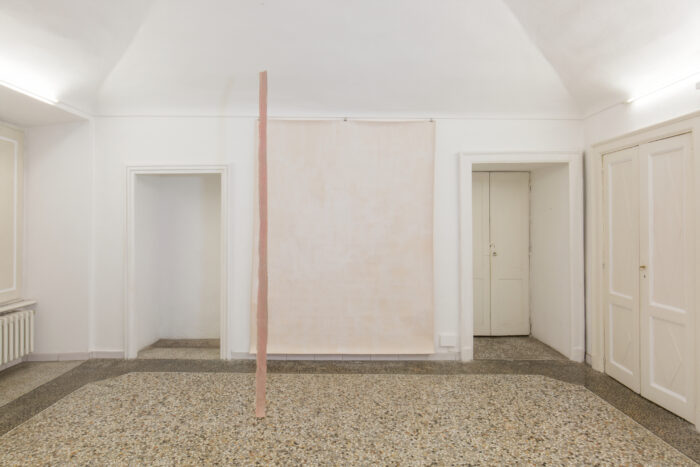
The white monochrome represents a zero degree, a surface waiting to be confronted. It is a void that marks a time, that of beginning, of waiting, of hope, and fear. An idea through images that presents painting as a moment to face with the same emotions with which one approaches a night walk in the mysterious cruising ritual. The strip of rough pink canvas hanging from the ceiling cuts through the space, an unsimpering reference to the sculptures Segmenti, that objectified painting used by Impellizzeri as an element of investigation on environment, where color is identified with light, and light is identified with space. This sculpture in the display, as in a dance, courts and is in turn courted by the white monochrome, which, waiting for something to happen, lets itself be marked by the piece of pink canvas.
In front of these two elements is the small oil landscape, Impellizzeri’s first fully figurative representation of a cruising. However, this is not a real landscape, it is not a path to be traced through the coordinates of a map. Here we are in a dreamlike territory where desires and dreams merge between pinks, blues, and greens.
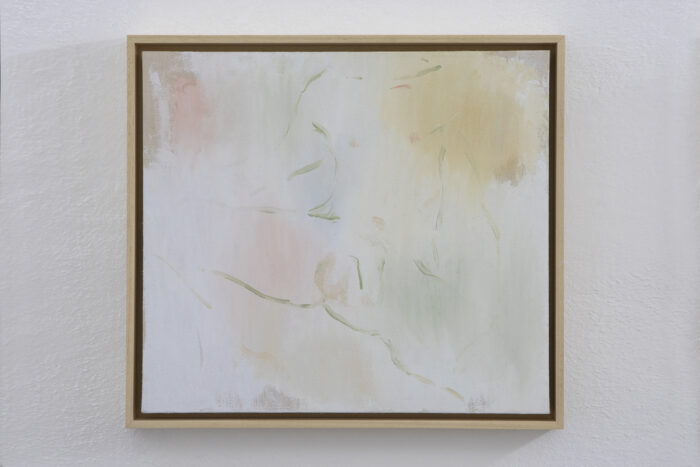
Central to the space is the polyptych made up of thirty small canvases belonging to the Keep smoking pictorial cycle, a research begun by the artist in 2015, the year in which he introduces object, plastic, and in some cases sculptural elements into his research. The recourse to matter starts with Keep smoking, canvases covered with pink Bravo rolling papers. It’s a drastic reduction of the palette: the entire color spectrum disappears in favor of pinks. Here the artist carries on the analytical lesson, voluntarily pulling it through a hybrid language that partially recalls the Cubist papiers collés. These are still lives composed with the fragments of the real world that become traces of an autobiographical story. The curator Samuele Piazza—invited to give a voice to the works on display—gives a punctual reading of the polyptych Keep smoking, which is only apparently subject to a modernist logic. A research that in Piazza’s opinion goes beyond Krauss idea of abstraction, to approach a sort of “queer abstraction”, theorized by the American writer Travis Jeppeness, a language of the body in which the body itself is not represented and is not present.
We read to this end: “The single pink ‘brushstrokes’ filling the surfaces of the almost-monochromes are replaced by tissue papers of a shade particularly dear to the artist’s colour palette, which can be found in some packs of rolling papers as a warning that the content is about to finish. Collected for years, this humble pictorial material is painstakingly readjusted to create a new pictorial surface.
The resulting grid is embodied in an apparently abstract narrative but, the use of objects charged with interpersonal meaning, linked to time duration, to a lived experience, perhaps to certain specific moments, and certainly to a relationship with the body and with addiction, the boundaries of this grid fade, embedding it with a narrative role in which the variations in shade correspond to different times and registers […].
In his works the places are redesigned starting from firsthand experience, from memory or after passing through events. The grid falls apart to make room for an inscrutable and illegible map, which gives back an atmosphere, perhaps a spell, in opposition to a zenithal visualization of places, similar to the Google Maps panopticon. Desire lurks between the mesh of the grid and in the dynamics triggered by unveiling and resistance, vision and imagination, matter and memory.”
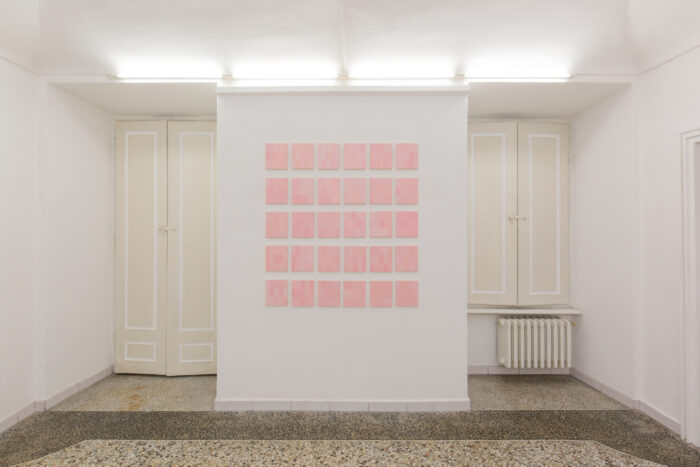
The references to the artist’s experience and to the map are not accidental. The surfacing of experience, of the autobiographical note, where instead the eye sees only spots of color or monochromes is always present in Impellizzeri’s painting. Going backwards, observing older works, we find Composizioni, thepictorial cycle started in 2015, a moment in which the artist dedicated himself to a research marked by the combination of color and light. In Composizioni, the palette refers back to that of the Italian analytical painter Riccardo Guarnieri, to pastel colors distilled by light.
The vibrant forms we see on the surface are not pure light, they exist as objects in a real world. Unlike Guarnieri, here light is not pure; it is shadows that indicate shapes. There is in Impellizzeri, unlike analytical painters, an almost uncontrolled impulse to tell, to sketch stories.
A painting is not just a painting: we are not dealing with an analytical artist, just as there is no recourse to the modernist lesson in his painting. So, the artwork is not just an artwork, and painting does not just talk about itself.
Piazza’s reference to the map and to Google Maps is not accidental, as I mentioned before: indeed, in 2017 Impellizzeri started the painting research of the Fêtes galantes, a heterogeneous body of works which includes canvases, gouaches, photographs, drawings, but mostly consists of paintings made on large, slightly crumpled sheets of paper, hung or rather suspended from the wall to preserve the natural plasticity of the support and to enhance its optical effect of lightness and fragility. In these works on paper the graphic aspect comes to the aid of compositional balance: the color is just hinted at among the thin folds of the sheet, evanescent as never before.
The reference to Giorgio Griffa is evident, as in the case of Keep smoking. A grid is once again the background of painted shapes, although in this case the folds on the paper are reminiscent of the folds of old road maps.
The numerical sequences standing in place of titles are in fact the geographical coordinates which indicate the precise spatial location of places in different cities: they are cruising areas, spaces used for sexual encounters en plein air. Formally, the analytical framework is always implied, only to be then betrayed and surpassed. Other expressive forms, linguistic and narrative, overlap that system. If with Compositions we are facing still lives, in the “maps” we are dealing with a surface that simulates another surface.
The play of cross-references between the real, the object and the abstract is always present in Impellizzeri’s research; his works are always subject to a narrative system, and the strong reductionist drive of forms and colors never completely frees himself from the narrative attributes linked to his personal biography.
Tracing them, says Impellizzeri, means “extending the painting far beyond the canvas, to the point of performing it in multiple times, multiple spaces, multiple tools. A painting that I begin at night, explored in multiple inspections, pursuits, conversations, and adventures, and thanks to which I can discover untraced and non-formal trails among the herbs, those trodden by obstinate searches for intimacy, driven by desire and excitement. It is a painting that I then continue in the light of my studio, where with painting I rework these paths in chromatic forms that retrace the behaviors and the most secret emotions of what Georges Bataille defines as ‘homo eroticus’. In such way of performing the painting act, the very detailed sketches that I make at night are a powerful support for my memory, and a stimulus to work”.
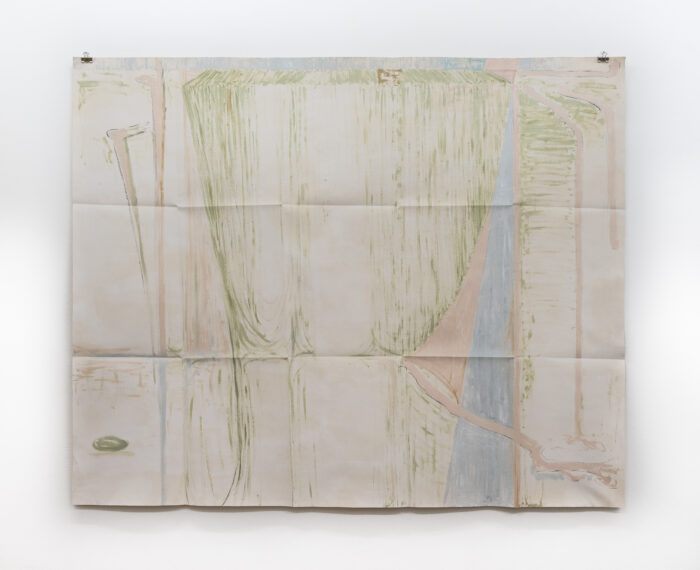
The works of Fêtes galantes present mostly a horizontal orientation and, even if each work would require an analysis of its own, it is possible to see, work after work, how the geometrizing blueprint fades in favor of a graphic and sign-based approach, up to a lyrical and abstract language going beyond the bi-dimensional appearance, in favor of surfaces and atmospheres that sink into the depths of the support.
The compositional coordinates of these maps are based on aerial views; indeed they are places seen from above. The language and style, as well as the reductionist action, are similar to those of the American painter Richard Diebenkorn, especially recalling the Ocean Park series; they often share its architecture, palette, and unfinished appearance.
The chromatic choice falls upon a palette of soft and chalky colors spread on opaque surfaces: each tonal composition, each pigment, as the artist highlights, “is chosen to compose the colors, serving to describe either a moment or an action that took place in that place, or the place itself. Thus, a madder pink lacquer combined with yellows and whites describes a movement, a blue mixed with payne gray and zinc white tells of an action that took place, and the natural green earth mixed with a light cadmium yellow is the very place where everything happens. The articulation of colors and signifying the contents composes in this way an obscure legend, one very difficult to read and of which I do not provide nor seek interpretations: the only content of the work is the color, and when a content is incorporated, it is no longer possible to remove it from its chromatic aspect”. The thin layers of paint allow Impellizzeri to exaggerate the luminous effect of evanescence where light obscures part of the forms, so that the structure as a whole lends itself to a reference of appearances and hiding, perhaps better to be defined disappearances, playing hide and seek with the very structure of the work, which appears and disappears, like certain images that appear and darken inside an eye blinded by light. It is a path of light that seems to kill color by blinding it, vaporizing it. Signs and backgrounds emaciated with tones identify with light, and light identifies with space. There is a highly controlled chromatic discipline in these works. By toning down his palette, Impellizzeri reaches the point of the almost monochrome, resulting in a series of paintings with very subtle balances, bordering the unstable and the broken.
If the Fêtes galantes are not exhibited, the reference to the pictorial cycle is expressly shown through Phthóngos, a movie recently produced by the artist. The title of the work—which is the first episode of a saga of seven—refers to a term used by Homer in the Odyssey to describe the song of the mermaids heard by Ulysses. The researcher Laura Pigozzi in the volume A nuda voce. Vocalità, Inconscio, Sessualità argues that this term should be understood as descriptive of a sound of nature caused either by animals or by natural phenomena, a song also understood as artistic, which is, in this case, vocalized by mermaids. The “phthóngos” of Impellizzeri’s movie refers to the sound pervading the scene for the entire duration of it: a sound that the artist himself recorded during a boat trip in 2016.
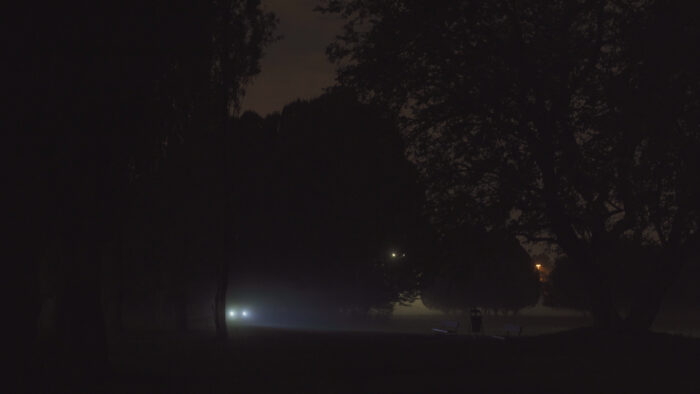
The movie is a sort of documentation of an action/performance made by the artist within a now dismissed cruising site. The phthóngos is used here as a mermaid song, as a bait to lure and bring back to these places the secret lovers who have left the park. In describing the movie, Samuele Piazza makes reference to Adorno and Horkheimer and argues: “The landscape immortalized in the video on display is a spot, once a place of fleeting encounters and battuage, today an abandoned corner of a park. The forest, in its tranquility, is reactivated through the headlights of a car that pierces darkness and humidity.
The siren song, recorded in a fortunate encounter in the middle of the sea, is amplified by the speakers of the car. The sound expands and penetrates every corner, reverberating on the surfaces and shaking them from their numbness. The energies once present in the now dormant place are reactivated by a call that seems to drive desiring bodies to itself and redesign a space with sound refractions. No human presence disturbs this unspoiled nature and the modulation of this pre-semantic song which, as Adorno and Horkheimer described in their Dialectic of the Enlightenment, seems to be the call of a repressed enjoyment asking to be freed to rejoin its prerational origin.
There is no narration, there is no word, but the stubborn silence of the grid is broken to reach an abstraction different from the modernist tabula rasa; the space loses its physical connotations to become a potential image in which a new corporality can manifest itself.”




